Ⅰ. Functions of resistors
Ⅱ. Classification of resistors
Ⅲ. Ideal Resistor
Ⅳ. Realistic Resistors
Ⅴ. Resistor labeling
Resistotor is one of the common components in the circuit, its basic function is to hinder the flow of electric current. In a circuit, the function of a resistor is to limit the magnitude of the current by consuming electric energy, thereby protecting other components in the circuit from being damaged by excessive current.
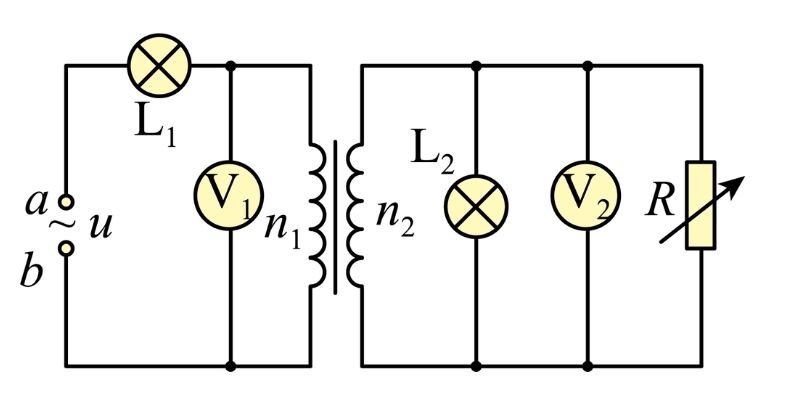
Ⅰ. Functions of resistors
1. Resistors can change the characteristics of a circuit. In the circuit, the resistance value of the resistor is different, which will have different effects on the characteristics of the circuit. For example, when the resistance in a circuit increases, the bandwidth of the circuit decreases and the attenuation of the signal increases. Therefore, resistors can be used to change the characteristics of the circuit, enabling the circuit to meet different needs.
2. Resistance can limit the size of the current. In a circuit, the greater the resistance of a resistor, the smaller the current flowing through it. This is because the resistor consumes electrical energy, converts it into heat and dissipates it, thereby limiting the amount of current flow. Therefore, resistors can be used to control the amount of current in a circuit and protect other components from being damaged by excessive current.
3. The resistor can adjust the voltage of the circuit. In a circuit, the greater the resistance value of a resistor, the smaller the current passing through it, thus reducing the voltage in the circuit. Therefore, resistors can be used to adjust the voltage in the circuit so that the components in the circuit can work properly.
4. Resistors can be used to divide voltage. In circuits, resistors can be used as voltage dividers, distributing voltage to different components. For example, when there are multiple components in the circuit that need to receive different voltages, resistors with different resistance values can be connected in series to realize voltage division, so that each component can get the required voltage.
5. The basic function of the resistor is to hinder the flow of current and limit the magnitude of the current by consuming electric energy, thereby protecting other components in the circuit from being damaged by excessive current. In addition, resistors can also be used to adjust the voltage of the circuit, change the characteristics of the circuit and divide the voltage, etc. Therefore, in circuit design and maintenance, resistance is one of the indispensable components.
Ⅱ. Classification of resistors
1. Classified by structure
Internal resistance: All electrical conductors except superconductors have a certain resistance, usually called internal resistance. In the ideal case of a battery or power supply, the internal resistance should be zero, which means that the power supply can supply an infinite amount of current or power, while the output voltage remains constant throughout.
Fixed-value resistor: A resistor made of resistive material or coil that will not vary due to any environmental or human factors. The current common fixed-value resistors have color stripes to identify the resistance value, error and other information. There are connecting wires at both ends of the fixed-value resistors to facilitate assembly; some fixed-value resistors in integrated circuits are in the form of mosaic.
Varistor: Also known as a rheostat, an accessory that changes the resistance value following the voltage level, usually made of varistor ceramics. Electronic components for voltage protection. The main function of the varistor is to limit and adjust the voltage in the circuit to protect other electronic components and equipment from excessive voltage shock or overvoltage damage.
The working principle is based on the properties of metal oxides. It consists of multiple oxide particles, usually zinc oxide.
Variable resistor: refers to all resistors whose resistance value can be changed manually. According to the occasion of use, variable resistors have other names such as voltage distributors and potentiometers. Common variable resistors have "three" connections. Different connection configurations allow the resistor to operate as a variable resistor, potentiometer, or fixed value resistor. A variable resistor usually consists of a filament or wire and a sliding contact or rotating structure. By adjusting the contact position between the contact and the wire, the effective length of the resistor can be changed, thereby adjusting the resistance value. Different adjustment methods will produce different types of variable resistors.
Thermistor: Its resistance value changes with temperature. Change the resistance value according to the temperature. One type of resistor, made of semiconductors, has a negative temperature coefficient, which mitigates the effects of temperature in electronic circuits. The operating principle of a thermistor is based on the temperature-sensitive nature of semiconductor materials.
Thermistors can be divided into PTC thermistors and NTC thermistors.
PTC Thermistor: Resistance value increases with temperature. As the temperature increases, the resistance value is positively correlated, which means that as the temperature increases, the resistance value also increases.
NTC thermistor: The resistance value decreases as the temperature increases. As the temperature increases, the resistance value has a negative relationship, which means that as the temperature increases, the resistance value decreases.
Photoresistor: It is a photosensitive sensor element, also known as photoresistive device or photoresistor. It is a resistor whose resistance value changes in response to changes in light intensity. The working principle of photoresistors is based on the light-sensitive nature of semiconductor materials. In the case of low light or no light, the resistance value of the photoresistor is higher. When there is strong light, the resistance value will be reduced to a lower level.
2. Classified by volt-ampere characteristics
Linear resistance: Its resistance value has a linear relationship with the passage of current. When the current increases, the resistance value also increases and changes according to a certain proportional relationship. It is used to limit current, adjust voltage, perform signal attenuation, and provide resistive voltage division and other functions. In many basic circuits, such as amplifier circuits, filter circuits, power control circuits, etc., linear resistors are one of the commonly used components.
Non-linear resistance: It is a resistance device whose resistance value does not conform to a linear relationship with current, voltage or other factors. The resistance value of a non-linear resistance device may be affected by factors such as current, voltage, temperature, and light, resulting in different curves of its resistance characteristics under different working conditions. The change in resistance value of a non-linear resistor device can be very curvilinear, unlike a linear resistor that simply follows Ohm's law.
dynamic resistance
Static resistance: Static resistance refers to the resistance value in the static state, that is, the resistance value when there is no current flow or no change in the circuit.
3. Classified by material
Metal oxide film resistors: metal oxide film resistors are formed by plating a layer of tin oxide on the porcelain tube, and depositing a layer of metal oxide on the insulating rod. Since it is an oxide itself, it is stable at high temperature, resistant to thermal shock, and has a strong load capacity. According to the application, there are general purpose, precision, high frequency, high voltage, high resistance, high power and resistance network, etc.
Carbon synthetic resistor: It is characterized by coating a layer of carbon film on the substrate of the resistor as a resistive material. Carbon composite resistors generally have lower manufacturing costs than other types of resistors and are therefore widely used in cost-sensitive applications. Carbon-synthetic resistors generally have a high temperature coefficient, i.e. their resistance value is highly sensitive to temperature changes and are therefore suitable for applications that require less temperature stability.
Metal film resistors: metal film resistors are formed by coating a layer of metal on the porcelain tube, and the alloy material is evaporated on the surface of the ceramic rod skeleton by vacuum evaporation. is a common resistor type characterized by the use of a metal film as the resistive material. Metal film resistors generally have high resistance value stability and precision, which can meet the requirements of many precision applications. Metal film resistors generally have a low temperature coefficient, that is, their resistance value is less sensitive to temperature changes, and are suitable for applications that require temperature stability.
Carbon film resistors: Carbon film resistors are a kind of film resistors, which are formed by depositing a layer of carbon film on the ceramic skeleton with crystalline carbon thermally decomposed by hydrocarbons under high temperature and vacuum. The resistance value is controlled by controlling the thickness of the carbon film and grooving the film. The outer surface of the resistor is generally coated with a green or orange protective paint. Carbon film resistors have low cost, stable performance, wide resistance range, low temperature coefficient and voltage coefficient, and are currently the most widely used resistors.
Wire-wound resistor: Wire-wound resistor is one of the more commonly used resistors. It is a resistor made of constantan, manganin or nickel complex alloy wire wound on a ceramic skeleton, with protective paint or glass glaze on the surface. Advantages: low noise, no current noise and non-linearity. Small temperature coefficient and good stability. Wire-wound resistors are a type of resistors that are wound with resistance wires on an insulating frame and then processed by insulating packaging. Wirewound resistors are generally divided into fixed and adjustable.
Fixed type: Usually wound with metal or alloy wire, such as nickel-chromium alloy or tungsten alloy, because these materials have good electrical resistance and high temperature resistance. The wound wire determines the resistance value by controlling the length and diameter, and then is connected to the terminals of the resistor by welding or soldering to form a complete wire wound fixed resistor. Since the length and diameter of the filament can be controlled during the winding process, the wirewound fixed resistor has high resistance value stability.
Adjustable type: An adjustable sliding contact or rotating structure is usually used to change the effective length of the resistor by changing the contact position between the contact and the wire wound wire, thereby adjusting the resistance value. This enables the wirewound adjustable resistor to flexibly adjust the resistance value within a certain range to meet the requirements of different circuits. Wirewound adjustable resistors can be mechanically adjusted to change the resistance value, making them suitable for circuits that require adjustable resistance. Wirewound adjustable resistors generally maintain good resistance value stability after adjustment.
4. Special resistors
Sensitive resistor: It means that its resistance value is sensitive to certain physical quantities (such as temperature, humidity, light, voltage, mechanical force, and gas concentration, etc.). When these physical quantities change, the resistance value of the sensitive resistor will change with the physical quantity, showing different resistance values. According to the sensitivity to different physical quantities, sensitive resistors can be divided into heat sensitive, humidity sensitive, light sensitive, pressure sensitive, force sensitive, magnetic sensitive and gas sensitive.
Insurance resistor: also known as fuse resistor, it plays the dual role of resistance and fuse under normal circumstances. When the circuit fails and its power exceeds the rated power, it will blow like a fuse to disconnect the connecting circuit. Fuse resistors generally have small resistance values (0.33Ω~10KΩ) and low power.
Ⅲ. Ideal Resistor
In an ideal resistor, the resistance value does not change with voltage or current, nor with sudden changes in current. Real resistors can't do that. Today's internal designs allow resistors to exhibit relatively small changes in resistance value under extreme voltage or current (as well as other environmental factors such as temperature).
Features:
There is a linear relationship between the resistance value and the current, which conforms to Ohm's law. The resistance value of an ideal resistor remains constant at all times and does not change with time, current, or voltage. An ideal resistor has a zero temperature coefficient, that is, changes in temperature have no effect on its resistance value.
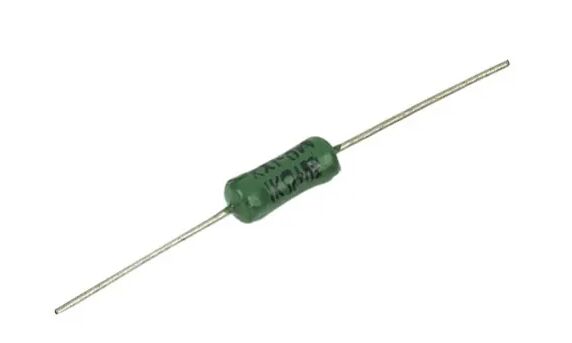
Ⅳ. Realistic Resistors
Realistic resistors refer to electronic components used in the real world, which are resistors that actually exist, as opposed to ideal resistors. Unlike ideal resistors, real resistors may be affected by some non-ideal factors in practical applications, resulting in certain differences in their resistance value and performance.
Every resistor has an upper limit for the voltage or current it can withstand (mainly depends on the size of the resistor). If the voltage or current is outside this range, first the resistance value of the resistor will change (in some resistors there can be a drastic change), and then the resistor will be destroyed due to overheating etc. Most resistors will be marked with a rated electrical power, while others will provide a rated current or voltage.
Features:
The resistance value of a real resistor is actually measured and is usually expressed in ohms (Ω). Different resistors have different resistance values, and the appropriate resistance value can be selected according to the application needs.
Realistic resistors produce a certain amount of power dissipation when current passes through them, converting electrical energy into heat. Therefore, the resistor needs to have sufficient power withstand capability to prevent overload damage.
Realistic resistors come in different package forms and sizes, such as through-hole resistors, surface mount resistors, etc., to suit different circuit layouts and application requirements.
Ⅴ. Resistor labeling
1. Color circle mark
Color ring marking is a commonly used marking method in electronic components, especially for components such as resistors and inductors. It represents the parameters and performance of the component by adding a set of colored rings on the shell or surface of the component.
There are usually four color rings printed on the resistor (there are also precision resistors with five color rings), each representing a different resistance value. The figure below is a comparison table between the resistance value and the color ring.
For example, there is a resistor with four color rings, the color rings of which are arranged in blue, gray, orange and gold, and its resistance value and error are:
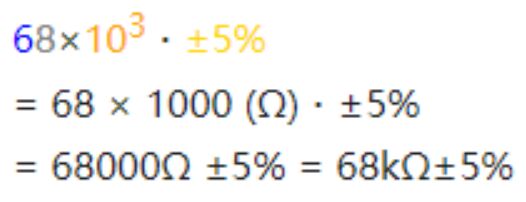
The color rings of resistors use international standard color codes, and each color corresponds to a number or parameter. For example, brown is 1, black is 0, red is 2, orange is 3, yellow is 4, green is 5, blue is 6, purple is 7, gray is 8, and white is 9. For inductors and other components, the color ring designation may be different, and the specific marking method will vary according to the type of component and the manufacturer's specification.

2. Surface mount resistors
It is a common electronic component widely used in modern electronic equipment and circuits. Unlike traditional through-hole resistors, surface mount resistors are directly soldered or pasted on the surface of a printed circuit board (PCB) without the need for insertion holes.
Larger size surface mount resistors will have numbers printed on them to indicate their resistance value. A surface mount resistor with a general error (5%) will use a three-digit number to indicate its resistance value. The first two digits are the first two significant digits of the resistance value, and the third digit is the power of ten (that is, add a few zeros after it). For example:
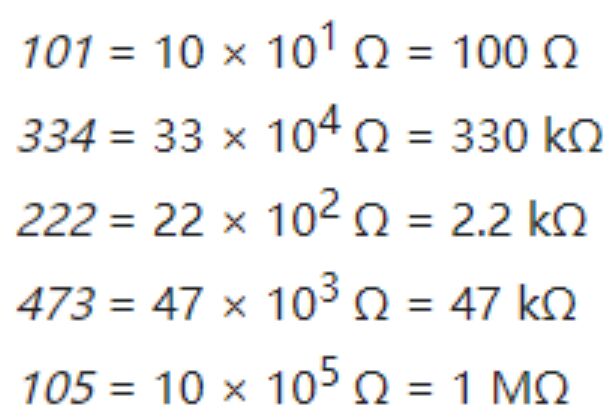
If the resistance value is less than 100, 100, 220, 470 will be written directly. The last zero means ten to the zeroth power, which is 1, for example:

If the resistance value is less than 10, the decimal point will be represented by English letters. For example:
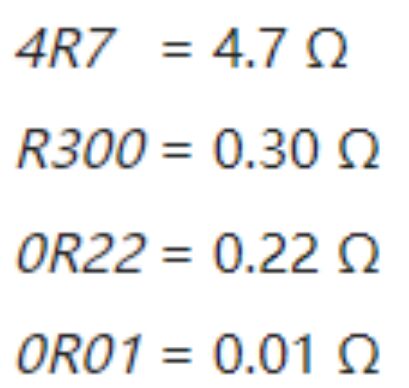
Precision resistors will be represented by four digits, the first three digits are the effective digits of the first three digits, and the fourth digit is the power of ten, for example:
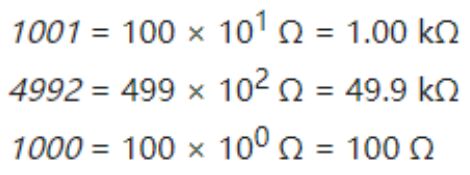
标签:resistors



